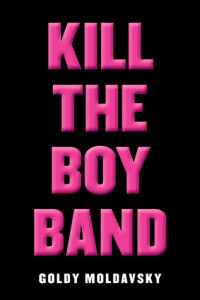What We’re Reading: Kill the Boy Band
 Kill the Boy Band by Goldy Moldavsky (Scholastic, February 2016)
Kill the Boy Band by Goldy Moldavsky (Scholastic, February 2016)
In honor of Women’s History Month, I chose a book that highlights one of the most easily dismissed and easily mocked subsets of women: the teenage girl.
“But you review YA!” you might be saying. “How can teenage girls be dismissed if they have a whole genre dedicated to them?”
That might be true. But if you look through criticisms of the genre, through the plethora of reviewers and publishers alike who deem YA frivolous or poorly-written, you’ll find that a lot of them have eerily misogynistic origins. From YA novels to boy bands to high school rom-coms, the list of things which are denigrated by our society solely because their fan base is made up of teenage girls goes on and on. It explains quite easily why so many girls—who turn into so many women—struggle with confidence and self-image. Why would you be proud of who you are when at every turn, you are mocked for being excited about something, for caring a little too much?
When I picked up Kill the Boy Band, I wasn’t quite sure which way it would go. With its clickbait-y title and bright pink letters, I wasn’t sure if it was going to be enforcing the stereotype that teenage girls are “crazy” and hormonal and dismissable, or if it was going to be a celebration, a dismantling of the sexist norms and a battlecry for girls liking things with unabashed enthusiasm.
Open the book, and you’re dropped right into the middle of the action. The narrator, a 15-year-old girl who never reveals her real name but instead uses a series of pseudonyms derived from 1980s John Hughes flicks, and her best friends, Erin, Apple, and Isabel, have camped out at a hotel in downtown Manhattan in hopes of catching a glimpse of their favorite boyband, The Ruperts. The Ruperts are a very thinly-veiled fictionalization of One Direction: four barely-teenaged boys, all named Rupert, who met on a United Kingdom vocal competition, were convinced to form a boyband, and now have an army of fangirls who call themselves Strepurs (Ruperts spelled backwards. And yes, if you’re wondering, the book does joke about the fact that Strepurs is pronounced “strippers”). Our narrator (we’ll call her Sloane for now, after Sloane Peterson, one of her many disguises) opens the door to her hotel room, only to find Rupert P. gagged and bound to a chair. The girls are forced to decide whether to follow through on this so-called accidental kidnapping or to let Rupert P. go, and deal with the repercussions. The book is a wild, ridiculous ride filled with macabre humor, conspiracy theories, and impossible situations. It’s the literary version of cotton candy—sickening sweet and nothing but fluff.
I wholeheartedly believe that every teenage girl on the planet goes through a “fangirl” stage. Maybe it’s not a boyband. Maybe it’s an actor, or a teacher, or an astrophysicist, or (in the case of this nerdy reviewer) a minor Harry Potter character. But I believe there comes a time in every teenage girl’s life when she falls head-over-heels in love with something bigger than herself. Fandom is something that Goldy Moldavsky nails completely on the head. Instead of gushing about it, I’ll just let Moldavsky’s narrator show you:
Other people may have seen fangirls as crazy teenage girls obsessed with a fad, but they couldn’t understand the small but important joy you can get from indulging in these fandoms. They didn’t get the friendships that formed, the community of people who shared in your same joy. Maybe it was obsession, but it was also happiness; an escape from the suckiness of everyday life. And when you find something that makes you happy and giddy and excited every day, us fangirls know a truth that everyone else seems to have forgotten: You hold onto that joy tenaciously, for as long as you can. Because it’s rare to get excited about anything these days. Ask your parents.
Yes, the book is humorous. Yes, it occasionally exaggerates and pokes fun at the fangirls. But it doesn’t feel like a condemnation. It feels like the gentle teasing of someone who has been on the inside.
Another aspect of this book that Moldavsky pulled off was the unreliable narration. Sloane is the ultimate teenager. She exaggerates. She gets overly excited about things. She plants just enough doubt in your mind to make it entirely feasible that she’s making up the whole thing. She’s unapologetically biased. Best of all, this effect is pulled off entirely naturally, never feeling forced or unnecessary.
I’ll be honest: for all that I enjoyed this book, it wasn’t perfect. It was a fun, lighthearted read, the kind that you need once in a while to escape from the “grown-up world.” But many, if not all, of the characters were one-dimensional. Plot points were introduced and then discarded with no resolution. At one point, a character reveals that she was almost sexually assaulted, and the incident is swept under the rug; later, the character is victim-blamed and made out to be unstable. The female friendships that I had hoped would be the foundation of this novel fell apart as Sloane decided she was better than her shallow, foolish comrades. There were many “one step forward, two steps back” moments for feminism in this book. It was a decent book, at the end of the day, but it was also entirely forgettable.
What other representations of fangirls/fandoms have you found? Are they positive portrayals?






